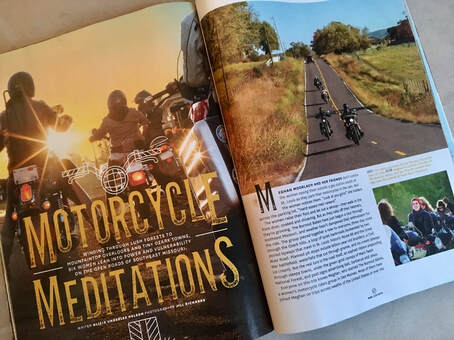
In this case they're riding a 300-mile loop to the southwest of St. Louis, but what really caught my attention is the writer's comment on an aspect of our sport we don't talk much about — danger.
Our daughter-in-law once commented that Patti & I take part in two recreational activities which reside near the top of the "most dangerous" list; motorcycling and horseback riding. I checked, turns out she's done her homework. We definitely don't see ourselves as daredevil adventurers, quite the opposite, as it seems to me that things like base jumping and rock climbing have more pain potential, but apparently not.
The author writes: "...the shadow side of a motorcycle's power is vulnerability — to the elements, to road conditions, to rider fatigue, to other drivers. On or off the road, the fragility of life always hangs close, unspoken but respected."
I've been riding for 48 years and learned on my own. I had two rookie single-vehicle bike crashes in my first year and none since, plus my share of close calls, mostly from other drivers. Motorcycle crash statistics are sobering, but a little sticky — they can be manipulated like any statistic. But here's a relevant sample: Motorcyclists in Colorado make up only 1% of miles traveled, but are 16.3% of the fatalities, and 75% of those were the rider's fault (Motorcycle Consumer News). The majority of bike crashes are single-vehicle and most are the result of simply running off the road. When another vehicle is involved, it's most likely an approaching car turning left in front of a bike. Somewhere around 50% of fatal crashes involve alcohol. And this: Most crash testing is done at 30mph and helmet certification is performed at only 24mph. Above those parameters and you've become your own crash test dummy.
You'll note that the word "accident" isn't used here. That's because insurers don't consider crashes to be accidental. There's always one or more contributing factors that might have been mitigated by those involved. In aviation, we learn to recognize and mitigate those factors the best we can, and there's a lesson there. The old saying, "there's old pilots and there's bold pilots, but there's no old, bold pilots" is a pithy way of saying that taking riding seriously should involve regular training, constant awareness and riding sober. All the things you've heard about motorcycle safety apply — speed is fun, but speed kills more effectively, riding above your or your bike's abilities, riding in bad weather, riding at night, riding with no protection, falsely assuming other drivers see you, and so forth.
Whenever someone asks me about taking up the sport, I find myself instinctively discouraging it. When they ask why, I almost always blurt out, "because it's dangerous." I know that I shouldn't discourage new riders, but I think of all the years of experience that help keep me (hopefully) safe on a motorcycle and cringe at the vulnerability of a new rider out in the real world after nothing more than some cursory classroom and parking lot training, especially if it involves a loved one. And that's too bad.
We all ride for our own reasons, every time we do we accept the risks that we know lurk in the shadows of our sport. As Orville Wright noted, "Carelessness and overconfidence are usually more dangerous than deliberately accepted risks."
...and then there's these guys..........
(skip to 1:15)
 RSS Feed
RSS Feed